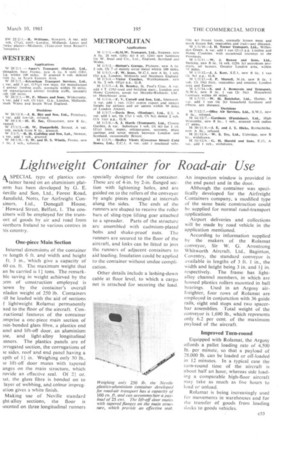Lightweight Container for Road-air Use
Page 91

If you've noticed an error in this article please click here to report it so we can fix it.
SPECIAL type of plastics conitainer based on an aluminium platorm has been developed by G. E. 4eville and Son, Ltd., Forest Road, rlansfleld, Notts, for Airfreight Conainers, Ltd., Donegall House, Howard Street, Belfast, 1. The conainers will be employed for the transion of goods by air and road from 4orthern Ireland to various centres in us country.
One-piece Main Section Internal dimensions of the container re length 6 ft. and width and height ft. 3 in., 'which give a capacity of 60 cu. ft. The maximum weight that an be carried is I+ tons. The remarkble saving in weight achieved by the Drm of construction employed is 'town by the container's overall nladen weight of 250 lb. Containers 411 be loaded with the aid of sections f lightweight Rolamat permanently xed to the floor of the aircraft. Conructional features of the container Dmprise a one-piece main section of !sin-bonded glass fibre, a plastics end and and lift-off door, an aluminium ase, and light-alloy longitudinal inners. The plastics panels are of 3rrugated section, the corrugations of le sides, roof and end panel having a epth of 1+ in. Weighing only 30 lb., le lift-off door mates with tapered anges on the main structure, which rovide an effective seal. Of 21 oz. tat, the glass fibre is bonded on to layer of webbing, and colour impregation gives a white finish.
Making use of Neville standard ght-alloy sections, the floor is iounted on three longitudinal runners specially designed for the container. These are of 4-in. by 2-in, flanged section with lightening holes, and are guided on to the rollers of the conveyor by angle pieces arranged at intervals along the sides. The ends of the runners are shaped to receive the roller bars of sling-type lifting gear attached to a spreader. Parts of the structure are assembled with cadmium-plated bolts and shake-proof nuts. The runners are secured to the floor of the aircraft, and links can be fitted to join the runners of adjacent containers to aid loading. Insulation could be applied to the container without undue compli cation.
Other details include a lashing-down cable at floor level, to which a cargo net is attached for securing the load. An inspection window is provided in the end panel and in the door.
Although the container was specifically developed for the Airfreight Containers company, a modified type of the same basic construction could be supplied for normal road-transport applications.
Airport deliveries and collections will be made by road vehicle in the application mentioned.
According to information supplied by the makers of the Rolamat conveyor, Sir W. G. Armstrong Whitworth Aircraft, Ltd., Baginton, Coventry, the standard conveyor is available in lengths of 3 ft. 1 in., the width and height being 3 in. and 11 in. respectively. The frame has lightalloy channel members, in which are housed plastics rollers mounted in ball bearings. Used in an Argosy airfreighter, four rows of Rolamat are employed in conjunction with 36 guide rails, eight end stops and two spacerbar assemblies. Total weight of the conveyor is 1,690 lb., which represents only 6.2 per cent. of the maximum payload of the aircraft.
Improved Turn-round
Equipped with Rolamat, the Argosy affords a pallet loading rate of 4,500 lb. per minute, so that a payload of 28.000 lb. can be loaded or off-loaded in 12 minutes. In a typical case the turn-round time of the aircraft is about half an hour, whereas side loading a comparable high-floor aircraft may take as much as five hours to load or unload.
Rolamat is being increasingly used for movements in warehouses and for the transfer of goods from loading decks to goods vehicles.












































































































































